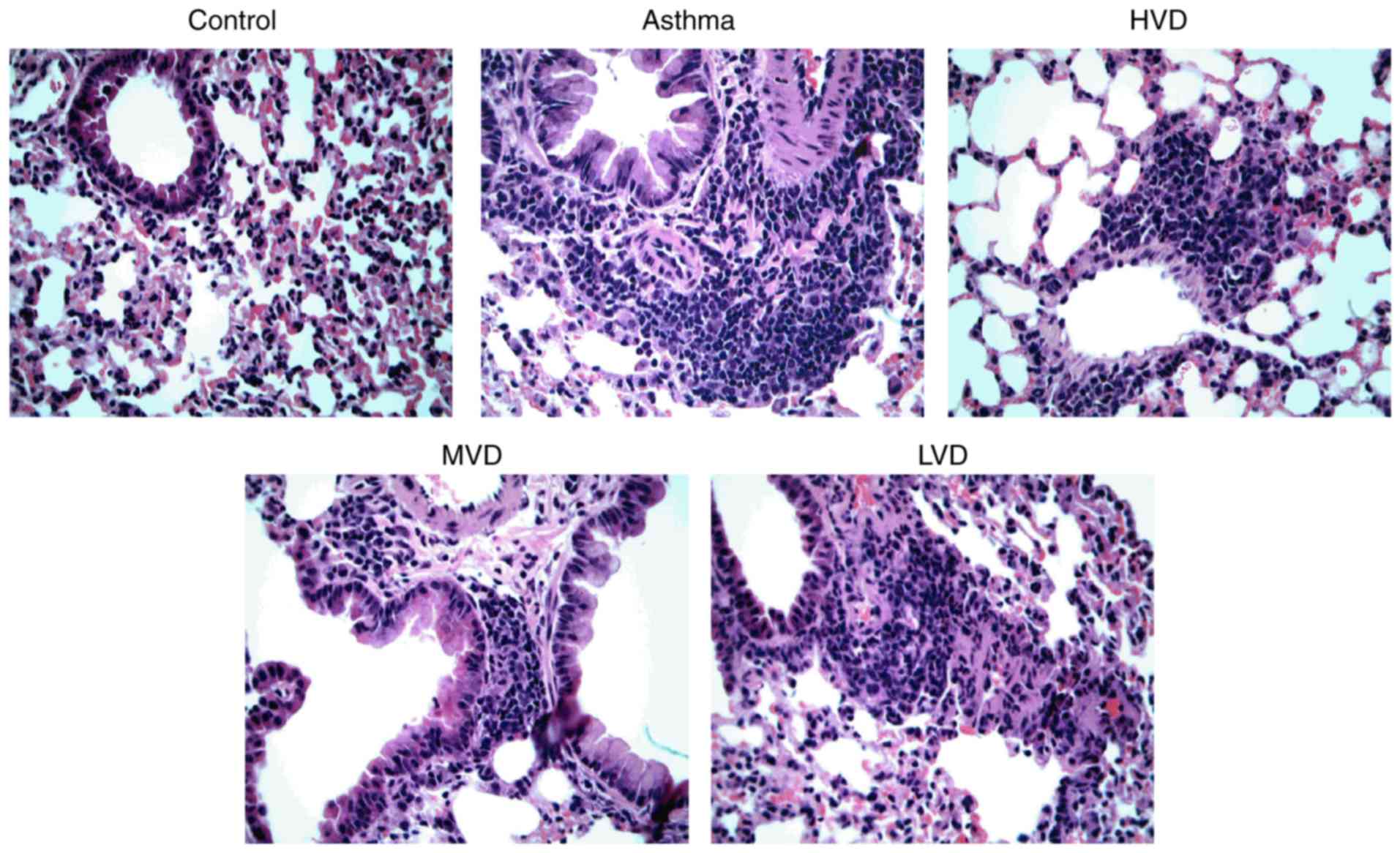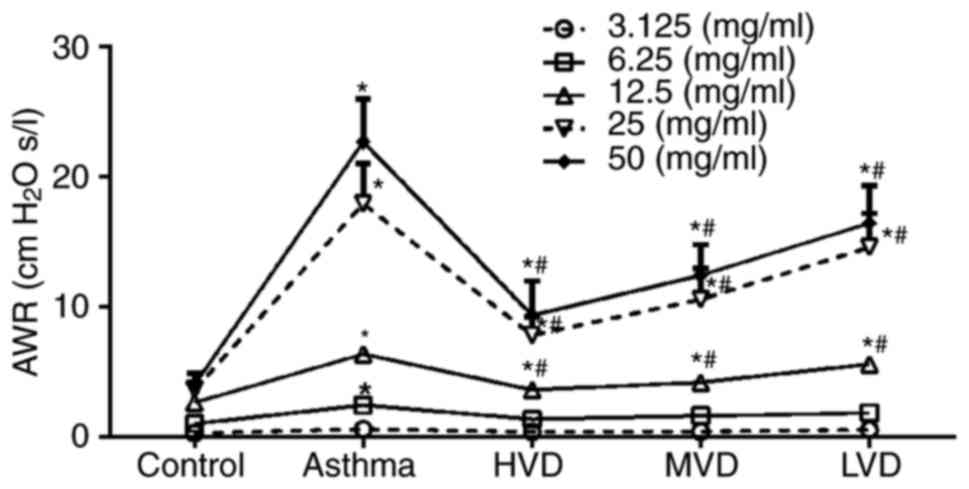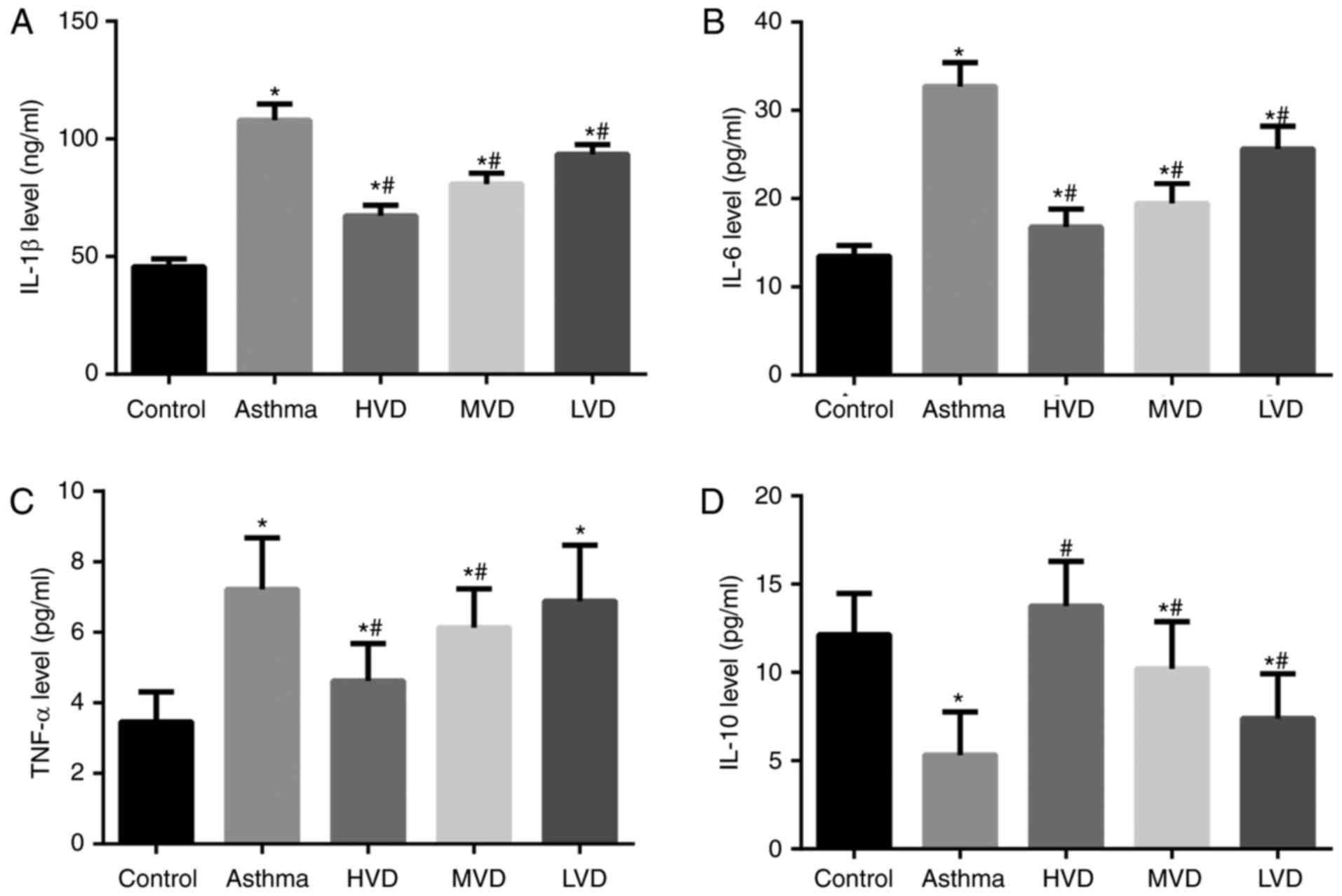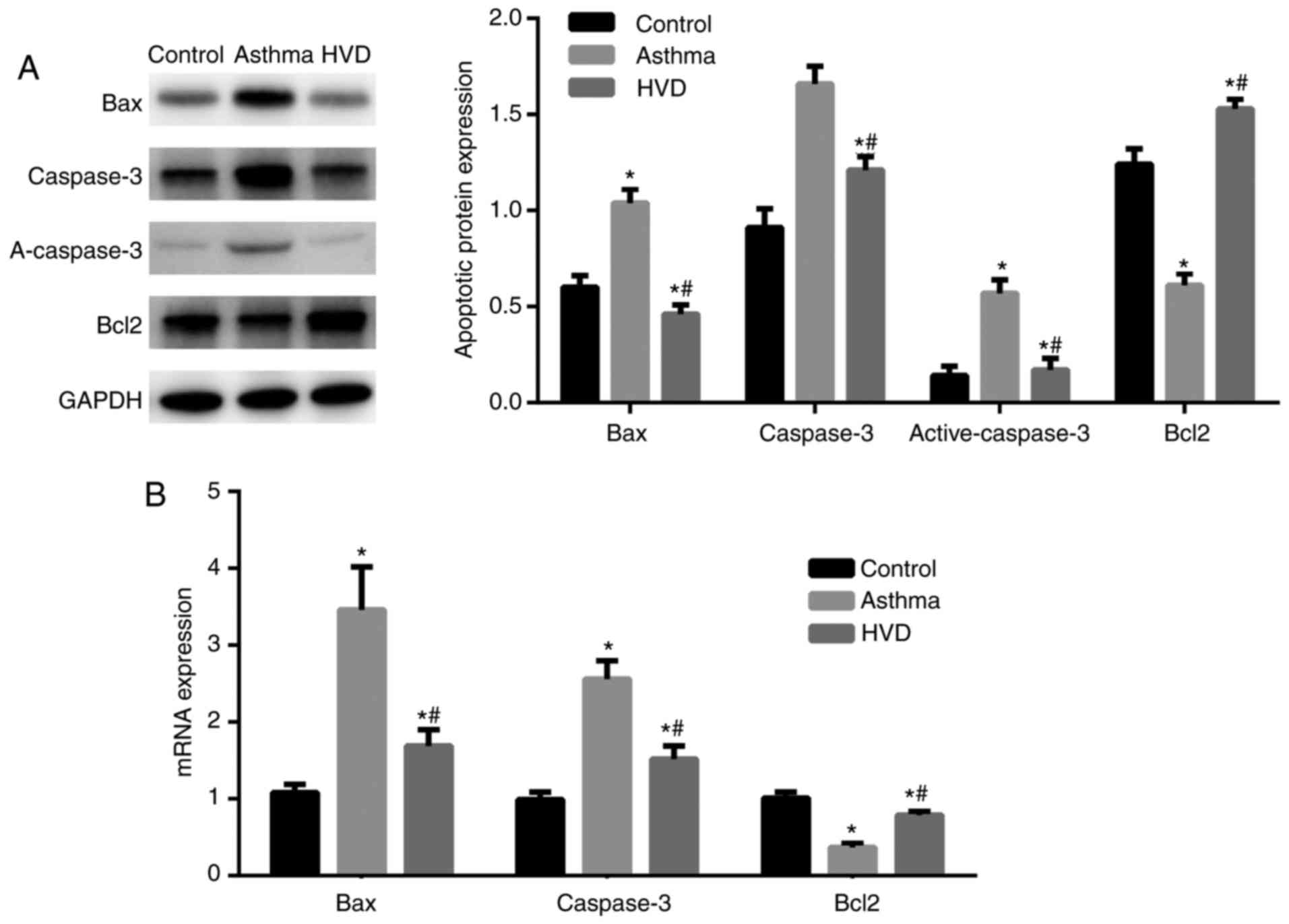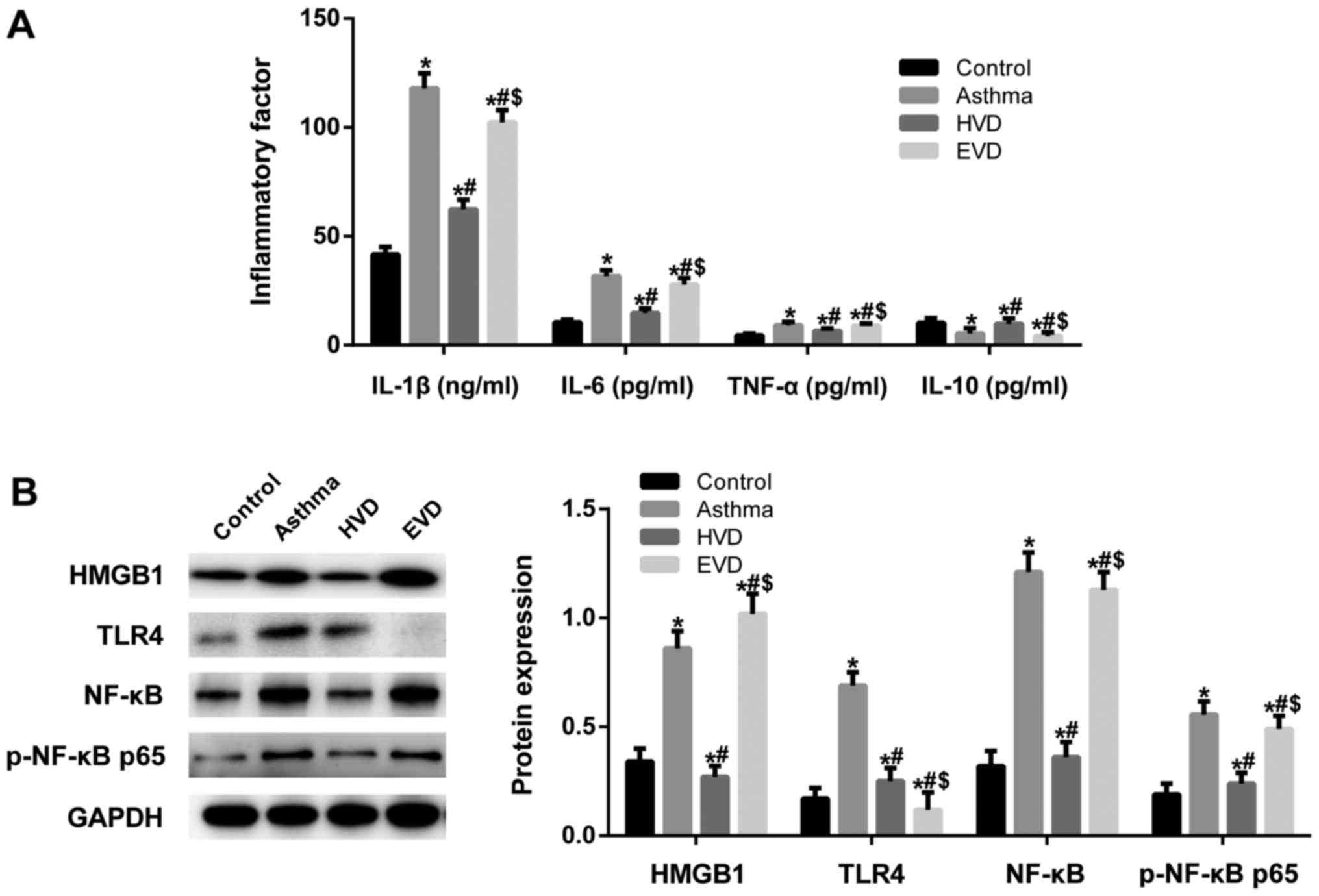Vitamin D reduces inflammatory response in asthmatic mice through HMGB1/TLR4/NF‑κB signaling pathway
- Authors:
- Published online on: December 7, 2017 https://doi.org/10.3892/mmr.2017.8216
- Pages: 2915-2920
-
Copyright: © Zhang et al. This is an open access article distributed under the terms of Creative Commons Attribution License.
Abstract
Introduction
Bronchial asthma is a chronic inflammatory respiratory disease that seriously affects human health (1). It develops from a chronic airway inflammation that involves eosinophils, lymphocytes, mast cells, neutrophils and other inflammatory cells and cell components (2–4). Approximately 300 million people worldwide currently suffer from asthma. The World Health Organization sponsored the World Asthma Day (the first Tuesday in May each year) to remind the public awareness of the disease and strengthen its prevention and treatment. At present, many asthma-related issues remain poorly understood. Therefore, it remains very important to investigate the pathogenesis of asthma and to look for new preventive and therapeutic targets in asthma.
High mobility group box 1 protein (HMGB1) is a highly conserved nuclear protein that can be used as an immunomodulatory factor and an inflammatory factor to participate in airway inflammation (5). Intranuclear HMGB1 mainly regulates DNA recombination, replication, repair and transcription (6). Extranuclear HMGB1 can be actively released by immune cells including monocytes/macrophages under the stimulation of inflammatory factors such as lipopolysaccharide, tumor necrosis factor (TNF)-α, and interleukin (IL)-1 and it can be passively released by necrotic cells in the early stage of tissue injury and necrosis (7–9). Extranuclear HMGB1, as an important endogenous proinflammatory factor and an inflammatory mediator, participates in the pathological process of various diseases such as sepsis, pneumonia, and arthritis (10–12).
Toll-like receptor-4 (TLR4) is an important immune pattern recognition receptor that controls innate and adaptive immune responses and plays an important role in initiating and regulating airway inflammation (13,14). TLR4 is the main receptor of HMGB1 (15). Nuclear factor (NF)-κB is located on the downstream TLR4 signaling pathway and is also in a pivotal position to regulate the immune response, cell proliferation and differentiation (16). Therefore, HMGB1/TLR4/NF-κB signaling pathway is an important part of immunoregulatory processes. It is also considered an important pathological mechanism underlying asthma. Regulation and intervention of any part of the signaling pathway may affect the occurrence and development of asthma.
Vitamin D (VD) is reportedly to be involved in many aspects of allergic and autoimmune diseases, exhibiting a remarkable immunoregulatory effect (17,18). There is evidence that VD receptor (VDR) gene is a new susceptibility gene for asthma (19). VD exhibits biological effects via binding to intracellular VDR, and its immunoregulatory effects on asthma has become an increasing area of interest. A previous study has demonstrated that 1,25-(OH)2D3 can downregulate the expression of MHC class II molecules and co-stimulatory molecules on antigen-presenting cell surface, prevent antigen presentation and T cell immune response, inhibit the expression of IL-4, interferon-γ, and IL-5, and thereby alleviate airway inflammation (20). In this study, we investigated the role of VD in a mouse model of asthma, and the mechanism of action of HMGB1/TLR4/NF-κB in asthma, providing a theoretical basis for clinical application of targeted drug therapy and development of new drugs against asthma.
Materials and methods
Animals and grouping
Healthy Balb/c mice, weighing 20–22 g, were purposed by Laboratory Animal Center, China Medical University, China. The experiments were approved by China Medical University Institutional Animal Care and Use Committee (IACUC; no. 20167642). Mice were randomly divided into six groups with 8 mice in each group: Normal control, asthma, asthma + high-dose VD (HVD), asthma + medium-dose VD (MVD), asthma + low-dose VD (LVD), asthma + VD + 40 µg/kg/d E5564 (EVD). Mice in the LVD group were daily administered a mixture of 0.1 µg/ml/20 g VD solution via the tail vein. Mice in the MVD group were identically administered a mixture of 0.4 µg/ml/20 g VD solution per day. Mice in the HVD group were identically injected with a mixture of a mixture of 1 µg/ml/20 g VD solution per day. Mice in the normal control group were daily injected with equal amounts of normal saline via the tail vein.
Establishment of mouse models of asthma
Mice in all groups with the exception of normal control group were intraperitoneally administered 0.2 ml antigen solution (50 µg ovalbumin + 0.15 ml 10% Al (OH)3 + 0.05 ml normal saline). Mice were immunized on experimental days 1, 8 and 15. On day 21, mice were placed in a closed container and sprayed with 5% ovalbumin and normal saline, once a day, 45 min each time, for 7 successive days. In the normal control group, only equal amount of normal saline was used to spray the mice. Mice in the HVD, MVD, and LVD groups were injected with VD solution via the tail vein 30 min before irritation.
Sample collection
On the day of asthma model establishment and on day 28 of intervention, blood samples were collected from mouse vein. Serum was separated and ELISA assay was performed. Mouse bronchial alveolar tissue was isolated. One portion of bronchial alveolar tissue was fixed in 10% formaldehyde and the other portion was used for western blot assay and reverse transcription-quantitative polymerase chain reaction (RT-qPCR; Bio-Rad Laboratories, Inc., Hercules, CA, USA).
Measurement of airway resistance in asthmatic mice
The airway resistance in asthmatic mice was measured at 24 h after the last spraying. Briefly, after anesthesia with sodium pentobarbital, a 22G indwelling needle was positioned for tracheal intubation and it was connected with a pulmonary function testing instrument. The mice were placed in a closed incubator to maintain body temperature at 37°C and assisted mechanical ventilation was given. Airway resistance (cm H2O/L/s) was measured. The airway resistance for mice inhaling PBS was designated as R (baseline) and the airway resistance for mice inhaling different concentrations of methacholine was designed as R (response) at the corresponding concentrations. The highest value of R at each concentration of methacholine was introduced into the following formula. The fold increase of R was used as an evaluation index of airway resistance: Fold increase of R=[R (response)-R (baseline)]/R (baseline).
Hematoxylin and eosin staining
Mouse bronchial alveolar tissue was dehydrated, cleared, embedded with paraffin, sliced, stained with hematoxylin for 5 min, washed with PBS, differentiated with hydrochloric acid-ethanol for 3 sec, stained with eosin for 2 min, and mounted with neutral resin. Finally, pathological change of mouse bronchial alveolar tissue was observed under the optical microscope.
ELISA assay
Serum levels of IL-1β (SEA563Mu, CCC), IL-6 (SEA079Mu, CCC), TNF-α (SEA134Mu, CCC) and IL-10 (SEA056Mu, CCC) were measured by ELISA assay according to kit instructions. A total of 100 µl standard sample and 100 µl diluted sample were added to the reaction plate and incubated at 37°C for 30 min. After washes, 100 µl tested sample was added to each well and then incubated at 37°C for 2 h. After washes, 100 µl horseradish peroxidase-labeled secondary antibody was added to each well. Samples were incubated at 37°C for 30 min. After washes, developer A and developer B, each 50 µl, was added. The tested sample was developed for 15 min in the dark. A stop solution was added at 50 µl per well to terminate the reaction. Optical density at 450 nm was read using an ELISA reader (EXL808; BioTek Instruments, Inc., Winooski, VT, USA). A standard curve was drawn. According to the curve equation, the concentration of the corresponding sample was calculated.
RT-qPCT
Mouse lung tissue was thoroughly ground into a powder and total RNA was extracted using 1 ml TRIzol (15596018; Invitrogen; Thermo Fisher Scientific, Inc., Waltham, MA, USA) according to the reagent operating instructions. First chain DNA was reverse transcribed. RT-qPCR was performed according to kit instructions (204057; Qiagen GmbH, Hilden, Germany). The relative gene expression data was analyzed with the 2−ΔΔCq method. The primers used for RT-qPCR are listed in Table I.
Western blot analysis
Mouse bronchial alveolar tissue was lysed using RIPA lysate containing protease inhibitor on ice and centrifuged. The supernatant was collected. Protein concentration was determined using a BCA protein assay kit. Protein samples were subjected to SDS-PAGE and then transferred onto PVDF membrane. Bax (ab32503; Abcam, Cambridge, UK), Bcl2 (ab59348; Abcam), caspase-3 (ab13847; Abcam), Active-caspase3 (ab47822; Abcam) HMGB1 (ab18256; Abcam), TLR4 (ab13867; Abcam), NF-κB (ab16502; Abcam) and p-NF-κB p65 (ab86299; Abcam) antibodies were added. Protein samples were incubated overnight at 4°C. PVDF membrane was washed with TBST. After horseradish peroxidase labeled secondary antibody was added, protein samples were incubated at room temperature for 2 h. Protein bands were visualized using an ECL chemiluminescence (Bio-Rad Laboratories, Inc.) detection kit and a gel imaging system. Absorbance analysis was performed using Image Tools.
Statistical analysis
All data were statistically analyzed using SPSS 19.0 software and are expressed as the mean ± standard deviation. t-test was used for pairwise comparison. One-way analysis of variance was performed for comparisons among groups. P<0.05 was considered to indicate a statistically significant difference.
Results
VD improves asthma symptoms in asthmatic mice
Compared with normal control mice, asthmatic mice had reduced activities, were irritable, exhibited running nose, sneezing and lackluster hair as well as deep and fast breathing, nodding while breathing, slow action, and cyanosis in lips after spraying. LVD group mice showed obvious runny nose and other asthma symptoms. MVD group the asthma symptoms has improved compared with LVD group. After treatment with HVD, the abovementioned symptoms alleviated, and mice breathed better and slow action was improved. Hematoxylin and eosin staining revealed that airway injury was obvious in asthmatic mice, a large number of inflammatory cells were infiltrated, and epithelial cells were poorly arranged (Fig. 1). After treatment with HVD, the number of infiltrated inflammatory cells was decreased. MVD and LVD group mice still have a lot of inflammatory cell infiltration. HVD exhibited better obvious therapeutic effects than MVD and LVD.
VD attenuates airway resistance in asthmatic mice
After spayed with different concentrations of methacholine, the airway resistance of asthmatic mice was obviously increased, but after treatment with HVD, airway resistance of asthmatic mice was significantly decreased (P<0.05, vs. asthma group) (Fig. 2). Airway resistance of asthmatic in LVD group had no significantly decreased, and in MVD group airway resistance of asthmatic mice was decreased, but it was no significantly improved compared with HVD. All these results suggest that VD can obviously attenuate the airway resistance of asthmatic mice.
VD reduces inflammatory response in asthmatic mice
ELISA results showed that serum levels of IL-1β, IL-6, TNF-α were significantly increased (Fig. 3A-C) and IL-10 was significantly decreased in the asthma group than in the normal control group (P<0.05) (Fig. 3D). After VD treatment, serum levels of IL-1β, IL-6, TNF-α were significantly decreased and IL-10 was significantly increased in the HVD group than in the asthma group (P<0.05). These results suggest that HVD can effectively reduce the inflammatory response in asthmatic mice.
VD reduces cell apoptosis in the lung tissue of asthmatic mice
Western blot analysis revealed that Bax, caspase-3 and active-caspase3 expression in the lung tissue was significantly increased, while Bcl-2 expression was significantly decreased, in the asthma group than those in the normal control group (P<0.05; Fig. 4A). Bax and caspase-3 expression in the lung tissue was significantly, while Bcl-2 expression was significantly increased in the HVD, MVD and LVD groups than those in the asthma group (P<0.05; Fig. 4B). These data suggest that VD can reduce cell apoptosis in the lung tissue of asthmatic mice.
VD reduces inflammatory response in asthmatic mice through HMGB1/TLR4/NF-κB signaling pathway
To investigate the mechanism of action of VD, we used TLR4 inhibitor E5564. ELISA results showed that after TLR4 was inhibited, the protective effects of VD disappeared (Fig. 5A). Western blot analysis revealed that HMGB, TLR4, NF-κB and p-NF-κB p65 expression levels in the lung tissue were significantly increased in the asthma group than those in the normal control group (P<0.05; Fig. 5B). HMGB, TLR4, NF-κB and p-NF-κB p65 expression levels were significantly decreased in the HVD, MVD and LVD groups than those in the asthma group (P<0.05). After the expression of TGF-β1 receptor was inhibited, HMGB, TLR4, NF-κB and p-NF-κB p65 expression levels in the lung tissue were significantly increased compared to those in the VD-treated groups (P<0.05). These data suggest that VD reduces inflammatory response in asthmatic mice through HMGB1/TLR4/NF-κB signaling pathway.
Discussion
In this study, asthma mouse model was established, data showed that HVD greatly attenuated the inflammatory response of bronchial alveolar cells and reduced apoptosis. This effect of VD is achieved through the HMGB1/TLR4/NF-κB signaling pathway.
Bronchial asthma is a common chronic respiratory inflammatory disease that occurs mostly in the autumn and is characterized by repeated and recurrent attacks and refractory treatment. Glucocorticoids are still the most effective drugs against bronchial asthma (21). But they do not really benefit asthma patients and only reduced the symptoms associated with asthma. Moreover, glucocorticoids have many adverse reactions and possess a number of health risks (22). Strong evidence exists that VD participates in the development of allergic and autoimmune diseases. Sadeghi et al found that VD can downregulate the expression of TLRs in the monocytes and reduce the production of pro-inflammatory cytokines such as TNF-α (23). Farhangi et al reported that VD effectively reduced the oxidative stress and inflammatory response of adipose tissue in a rat model of high fat diet-induced obesity (24). Our results revealed that VD treatment greatly reduced the airway inflammatory response and cellular apoptosis in the lung tissue of a mouse model of asthma.
The pathological mechanism of bronchial asthma is very complex and inflammation is the pathological basis. HMGB1 as a nucleoprotein was discovered through purification in the 1970s together with chromosomal DNA.
Intranuclear HMGB1 mainly regulates DNA replication, repair and transcription. When cells are stimulated by inflammation, nuclear membrane permeability was increased, HMGB1 exudes into the cytoplasm, and then released into the extracellular environment by neutrophils, monocytes/macrophages, and other inflammatory cells, act as an extracellular signal transporter through binding to other receptors on the cell surface to exert pro-inflammatory effects (25).
TLR4 is an important pattern recognition receptor and it is highly expressed on immune cells including macrophages, neutrophils, and dendritic cells (26). TLR4 mainly functions to mediate the maturation of dendritic cells, releases interleukin-12, promotes the synthesis and release of cytokines, contributing to production of inflammatory response (27). TLR4 signaling is a process that activates NF-κB, initiates inflammatory mediators-related gene transcription, and promotes the production of inflammatory factors through myeloid differentiation proteins (MyD88)-dependent and -independent signaling pathway (28). HMGB1 can act as an endogenous ligand, binds to TLR4, activates downstream NF-κB, and induces immune response and inflammatory response (29). Lee et al found that HMGB1, TLR2 and TLR4 expression in the lung tissue was obviously increased in a mouse model of asthma-induced by ovalbumin (30). After anti-HMGB1 treatment, airway inflammation, mucous membrane formation, collagen deposition, and TLR2 and TLR4 expression were significantly reduced. Our results showed that after inhibition of TLR4, the anti-inflammatory effects of VD disappeared, presuming that VD may compete with HMGB1 to bind to TLR4, thus inhibiting the pro-inflammatory effects of HMGB1.
Our results showed that VD reduced the inflammatory response and apoptosis in lung tissue in asthmatic mice through HMGB1/TLR4/NF-κB signaling pathway. This provides a theoretical basis for clinical application of targeted drug therapy and development of new drugs against asthma.
Acknowledgements
This study was supported by the Liaoning provincial clinical capacity-building project LNCCC-C02-2015.
References
|
Vora AC: Bronchial asthma. J Assoc Physicians India. 62 3 Suppl:S5–S6. 2014. | |
|
Yu HY, Li XY, Cai ZF, Li L, Shi XZ, Song HX and Liu XJ: Eosinophil cationic protein mRNA expression in children with bronchial asthma. Genet Mol Res. 14:14279–14285. 2015. View Article : Google Scholar : PubMed/NCBI | |
|
Ciepiela O, Ostafin M and Demkow U: Neutrophils in asthma-a review. Respir Physiol Neurobiol. 209:13–16. 2015. View Article : Google Scholar : PubMed/NCBI | |
|
Erokhina IL, Voronchikhin PA, Okovityĭ SV and Emel'ianova OI: Reaction of population of pulmonary mast cells in rat bronchial asthma under the effect of β-adrenoreceptor antagonists. Tsitologiia. 55:472–474. 2013.(In Russian). PubMed/NCBI | |
|
Yang H, Antoine DJ, Andersson U and Tracey KJ: The many faces of HMGB1: Molecular structure-functional activity in inflammation, apoptosis, and chemotaxis. J Leukoc Biol. 93:865–873. 2013. View Article : Google Scholar : PubMed/NCBI | |
|
Smolarczyk R, Cichoń T, Jarosz M and Szala S: HMGB1-its role in tumor progression and anticancer therapy. Postepy Hig Med Dosw (Online). 66:913–920. 2012.(In Polish). View Article : Google Scholar : PubMed/NCBI | |
|
Kamo N, Ke B, Ghaffari AA, Shen XD, Busuttil RW, Cheng G and Kupiec-Weglinski JW: ASC/caspase-1/IL-1β signaling triggers inflammatory responses by promoting HMGB1 induction in liver ischemia/reperfusion injury. Hepatology. 58:351–362. 2013. View Article : Google Scholar : PubMed/NCBI | |
|
Wang T, Wei XY, Liu B, Wang LJ and Jiang LH: Effects of propofol on lipopolysaccharide-induced expression and release of HMGB1 in macrophages. Braz J Med Biol Res. 48:286–291. 2015. View Article : Google Scholar : PubMed/NCBI | |
|
Willenbrock S, Braun O, Baumgart J, Lange S, Junghanss C, Heisterkamp A, Nolte I, Bullerdiek J and Murua Escobar H: TNF-α induced secretion of HMGB1 from non-immune canine mammary epithelial cells (MTH53A). Cytokine. 57:210–220. 2012. View Article : Google Scholar : PubMed/NCBI | |
|
Fink MP: HMGB1 as a drug target in staphylococcal pneumonia. Crit Care. 18:1312014. View Article : Google Scholar : PubMed/NCBI | |
|
Wang WJ, Yin SJ and Rong RQ: PKR and HMGB1 expression and function in rheumatoid arthritis. Genet Mol Res. 14:17864–17870. 2015. View Article : Google Scholar : PubMed/NCBI | |
|
Wang H, Ward MF and Sama AE: Targeting HMGB1 in the treatment of sepsis. Expert Opin Ther Targets. 18:257–268. 2014. View Article : Google Scholar : PubMed/NCBI | |
|
Hu X, Yu Y, Eugene Chin Y and Xia Q: The role of acetylation in TLR4-mediated innate immune responses. Immunol Cell Biol. 91:611–614. 2013. View Article : Google Scholar : PubMed/NCBI | |
|
Pascual M, Fernández-Lizarbe S and Guerri C: Role of TLR4 in ethanol effects on innate and adaptive immune responses in peritoneal macrophages. Immunol Cell Biol. 89:716–727. 2011. View Article : Google Scholar : PubMed/NCBI | |
|
Wan Z, Zhang X, Peng A, He M, Lei Z and Wang Y: TLR4-HMGB1 signaling pathway affects the inflammatory reaction of autoimmune myositis by regulating MHC-I. Int Immunopharmacol. 41:74–81. 2016. View Article : Google Scholar : PubMed/NCBI | |
|
Kang N, Hai Y, Yang J, Liang F and Gao CJ: Hyperbaric oxygen intervention reduces secondary spinal cord injury in rats via regulation of HMGB1/TLR4/NF-κB signaling pathway. Int J Clin Exp Pathol. 8:1141–1153. 2015.PubMed/NCBI | |
|
Sperl A and Klimek L: Role of vitamin D in allergic diseases: Current research status. HNO. 63:352–356. 2015.(In German). View Article : Google Scholar : PubMed/NCBI | |
|
Agmon-Levin N, Theodor E, Segal RM and Shoenfeld Y: Vitamin D in systemic and organ-specific autoimmune diseases. Clin Rev Allergy Immunol. 45:256–266. 2013. View Article : Google Scholar : PubMed/NCBI | |
|
Maalmi H, Sassi FH, Berraies A, Ammar J, Hamzaoui K and Hamzaoui A: Association of vitamin D receptor gene polymorphisms with susceptibility to asthma in Tunisian children: A case control study. Hum Immunol. 74:234–240. 2013. View Article : Google Scholar : PubMed/NCBI | |
|
Amento EP: Vitamin D and the immune system. Steroids. 49:55–72. 1987. View Article : Google Scholar : PubMed/NCBI | |
|
EmeI'yanov AV: The therapeutic potential of inhalation glucocorticoids in patients with bronchial asthma. Klin Med (Mosk). 93:23–29. 2015.(In Russian). | |
|
Oray M, Abu Samra K, Ebrahimiadib N, Meese H and Foster CS: Long-term side effects of glucocorticoids. Expert Opin Drug Saf. 15:457–465. 2016. View Article : Google Scholar : PubMed/NCBI | |
|
Sadeghi K, Wessner B, Laggner U, Ploder M, Tamandl D, Friedl J, Zügel U, Steinmeyer A, Pollak A, Roth E, et al: Vitamin D3 down-regulates monocyte TLR expression and triggers hyporesponsiveness to pathogen-associated molecular patterns. Eur J Immunol. 36:361–370. 2006. View Article : Google Scholar : PubMed/NCBI | |
|
Farhangi MA, Mesgari-Abbasi M, Hajiluian G, Nameni G and Shahabi P: Adipose tissue inflammation and oxidative stress: The ameliorative effects of vitamin D. Inflammation. Jul 3–2017.(Epub ahead of print). View Article : Google Scholar : PubMed/NCBI | |
|
Tang D, Shi Y, Kang R, Li T, Xiao W, Wang H and Xiao X: Hydrogen peroxide stimulates macrophages and monocytes to actively release HMGB1. J Leukoc Biol. 81:741–747. 2007. View Article : Google Scholar : PubMed/NCBI | |
|
Ottow MK, Klaver EJ, van der Pouw Kraan TC, Heijnen PD, Laan LC, Kringel H, Vogel DY, Dijkstra CD, Kooij G and van Die I: The helminth Trichuris suis suppresses TLR4-induced inflammatory responses in human macrophages. Genes Immun. 15:477–486. 2014. View Article : Google Scholar : PubMed/NCBI | |
|
Kim HS and Chung DH: TLR4-mediated IL-12 production enhances IFN-γ and IL-1β production, which inhibits TGF-β production and promotes antibody-induced joint inflammation. Arthritis Res Ther. 14:R2102012. View Article : Google Scholar : PubMed/NCBI | |
|
Zhu HT, Bian C, Yuan JC, Chu WH, Xiang X, Chen F, Wang CS, Feng H and Lin JK: Curcumin attenuates acute inflammatory injury by inhibiting the TLR4/MyD88/NF-κB signaling pathway in experimental traumatic brain injury. J Neuroinflammation. 11:592014. View Article : Google Scholar : PubMed/NCBI | |
|
Qiao JY, Song L, Zhang YL and Luan B: HMGB1/TLR4/NF-κB signaling pathway and role of vitamin D in asthmatic mice. Zhongguo Dang Dai Er Ke Za Zhi. 19:95–103. 2017.(In Chinese). PubMed/NCBI | |
|
Lee CC, Lai YT, Chang HT, Liao JW, Shyu WC, Li CY and Wang CN: Inhibition of high-mobility group box 1 in lung reduced airway inflammation and remodeling in a mouse model of chronic asthma. Biochem Pharmacol. 86:940–949. 2013. View Article : Google Scholar : PubMed/NCBI |



